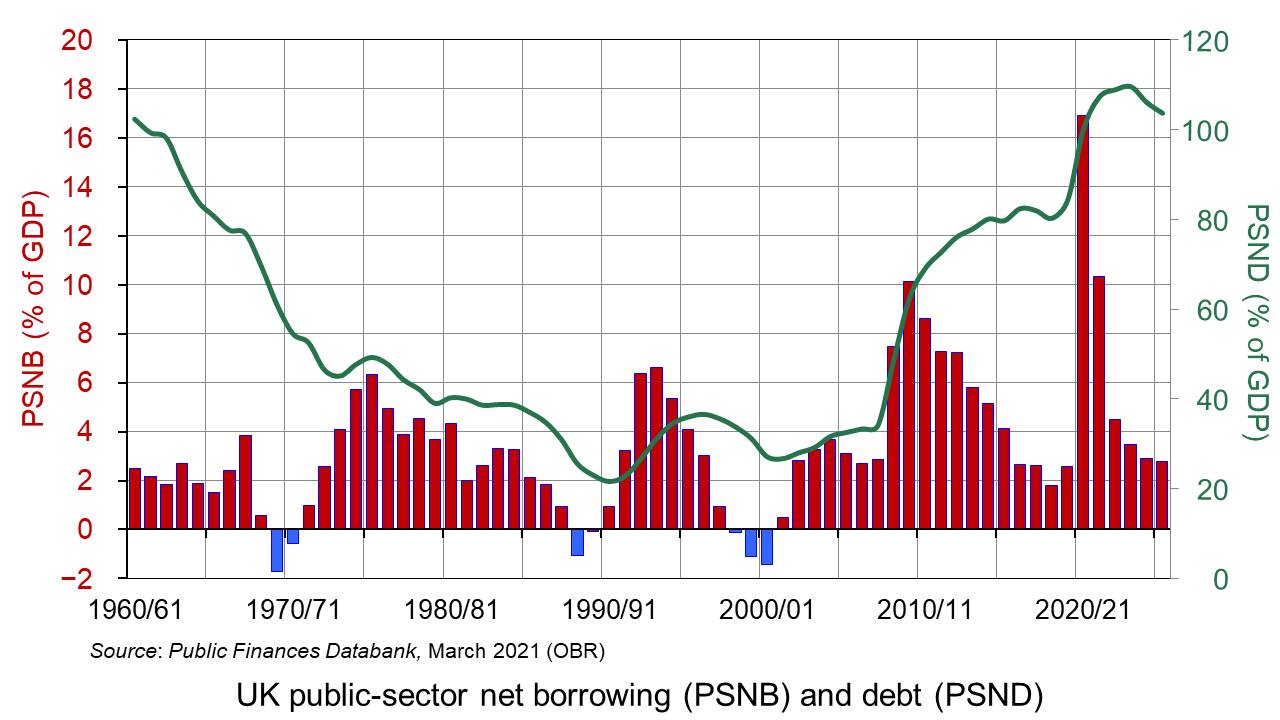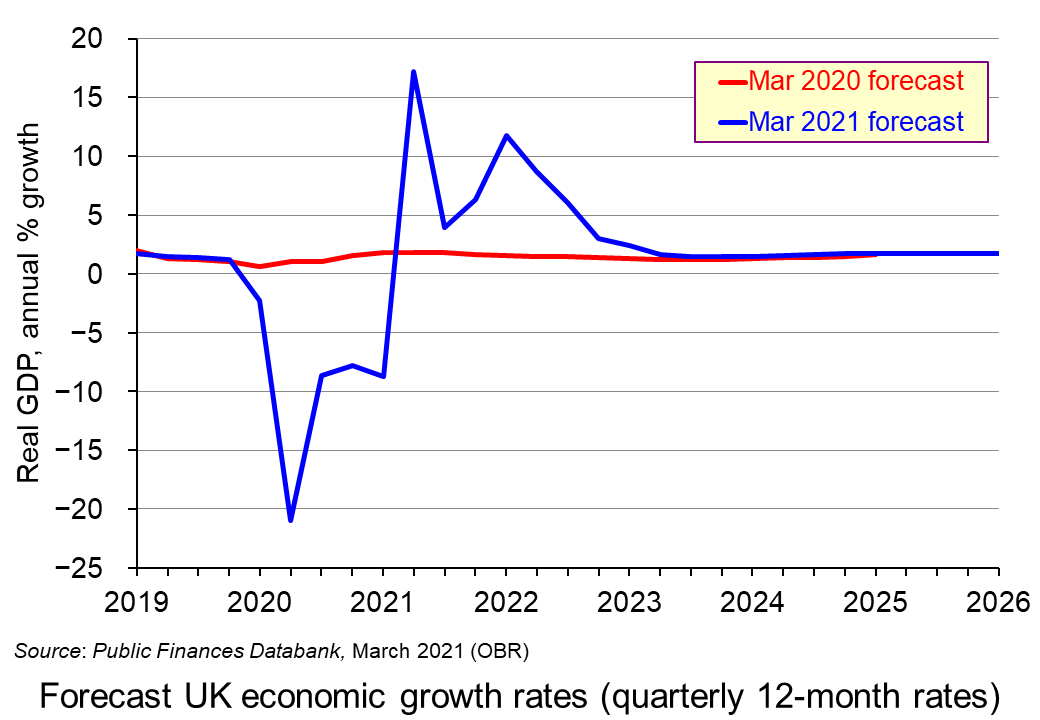 Rishi Sunak delivered his 2021 UK Budget on 3 March. It illustrates the delicate balancing act that governments in many countries face as the effects of the coronavirus pandemic persist and public-sector debt soars. He announced that he would continue supporting the economy through various forms of government expenditure and tax relief, but also announced tax rises over the medium term to begin addressing the massively increased public-sector debt.
Rishi Sunak delivered his 2021 UK Budget on 3 March. It illustrates the delicate balancing act that governments in many countries face as the effects of the coronavirus pandemic persist and public-sector debt soars. He announced that he would continue supporting the economy through various forms of government expenditure and tax relief, but also announced tax rises over the medium term to begin addressing the massively increased public-sector debt.
Key measures of support for people and businesses include:
- An extension of the furlough scheme until the end of September, with employees continuing to be paid 80% of their wages for hours they cannot work, but with employers having to contribute 10% in July and 20% in August and September.
- Support for the self-employed also extended until September, with the scheme being widened to make 600 000 more self-employed people eligible.
- The temporary £20 increase to Universal Credit, introduced in April last year and due to end on 31 March this year, to be extended to the end of September.
- Stamp duty holiday on house purchases in England and Northern Ireland, under which there is no tax liability on sales of less than £500 000, extended from the end of March to the end of June.
- An additional £1.65bn to support the UK’s vaccination rollout.
- VAT rate for hospitality firms to be maintained at the reduced 5% rate until the end of September and then raised to 12.5% (rather than 20%) for a further six months.
- A range of grants for the arts, sport, shops , other businesses and apprenticeships.
- Business rates holiday for hospitality firms in England extended from the end of March to the end of June and then with a discount of 66% until April 2022.
- 130% of investment costs can be offset against tax – a new tax ‘super-deduction’.
- No tax rises on alcohol, tobacco or fuel.
- New UK Infrastructure Bank to be set up in Leeds with £12bn in capital to support £40bn worth of public and private projects.
- Increased grants for devolved nations and grants for 45 English towns.
It has surprised many commentators that there was no announcement of greater investment in the NHS or more money for social care beyond the £3bn for the NHS and £1bn for social care announced in the November Spending Review. The NHS England budget will fall from £148bn in 2020/21 to £139bn in 2021/22.
Effects on borrowing and GDP

The net effect of these measures for the two financial years 2020 to 2022 is forecast by the Treasury to be an additional £37.5bn of government expenditure and a £27.3bn reduction in tax revenue (see Table 2.1 in Budget 2021). This takes the total support since the start of the pandemic to £352bn across the two years.
According to the OBR, this will result in public-sector borrowing being 16.9% of GDP in 2020/21 (the highest since the Second World War) and 10.3% of GDP in 2021/22. Public-sector debt will be 107.4% of GDP in 2021/22, rising to 109.7% in 2023/24 and then falling to 103.8% in 2025/26.
 Faced with this big increase in borrowing, the Chancellor also announced some measures to raise tax revenue beginning in two years’ time when, hopefully, the economy will have grown. Indeed, the OBR forecasts that GDP will grow by 4.0% in 2021 and 7.3% in 2022, with the growth rate then settling at around 1.7% from 2023 onwards. He announced that:
Faced with this big increase in borrowing, the Chancellor also announced some measures to raise tax revenue beginning in two years’ time when, hopefully, the economy will have grown. Indeed, the OBR forecasts that GDP will grow by 4.0% in 2021 and 7.3% in 2022, with the growth rate then settling at around 1.7% from 2023 onwards. He announced that:
- Corporation tax on company profits over £250 000 will rise from 19% to 25% in April 2023. Rates for profits under £50 000 will remain at the current rate of 19%, with the rate rising in stages as profits rise above £50 000.
- Personal income tax thresholds will be frozen from 2022/23 to 2025/26 at £12 570 for the basic 20% marginal rate and at £50 270 for the 40% marginal rate. This will increase the average tax rate as people’s nominal incomes rise.
 The policy of a fiscal boost now and a fiscal tightening later might pose political difficulties for the government as this does not fit with the electoral cycle. Normally, politicians like to pursue tighter policies in the early years of the government only to loosen policy with various giveaways as the next election approaches. With Rishi Sunak’s policies, the opposite is the case, with fiscal policy being tightened as the 2024 election approaches.
The policy of a fiscal boost now and a fiscal tightening later might pose political difficulties for the government as this does not fit with the electoral cycle. Normally, politicians like to pursue tighter policies in the early years of the government only to loosen policy with various giveaways as the next election approaches. With Rishi Sunak’s policies, the opposite is the case, with fiscal policy being tightened as the 2024 election approaches.
Another issue is the high degree of uncertainty in the forecasts on which he is basing his policies. If there is another wave of the coronavirus with a new strain resistant to the vaccines or if the scarring effects of the lockdowns are greater, then growth could stall. Or if inflation begins to rise and the Bank of England feels it must raise interest rates, then this would suppress growth. With lower growth, the public-sector deficit would be higher and the government would be faced with the dilemma of whether it should raise taxes, cut government expenditure or accept higher borrowing.
What is more, there are likely to be huge pressures on the government to increase public spending, not cut it by £4bn per year in the medium term as he plans. As Paul Johnson of the IFS states:
In reality, there will be pressures from all sorts of directions. The NHS is perhaps the most obvious. Further top-ups seem near-inevitable. Catching up on lost learning in schools, dealing with the backlog in our courts system, supporting public transport providers, and fixing our system for social care funding would all require additional spending. The Chancellor’s medium-term spending plans simply look implausibly low.
Articles and Briefings
- Budget 2021: Key points at-a-glance
BBC News (3/3/21)
- Budget 2021: Full round-up of what Chancellor Rishi Sunak has announced
MoneySavingExpert, Callum Mason (3/3/21)
- Budget 2021 at a glance: The key points from Chancellor Rishi Sunak’s speech
This is Money, Alex Sebastian (3/3/21)
 Budget 2021
Budget 2021IFS (3/3/21)
- Rishi Sunak delivers spend now, tax later Budget to kickstart UK economy
Financial Times, Jim Pickard, Chris Giles and George Parker (3/3/21)
- Swifter and more sustained? What did we learn about the UK’s economic outlook from Rishi Sunak’s Budget?
Independent. Ben Chu (3/3/21)
- Spending fast, taxing slow: Briefing Note
Resolution Foundation, Torsten Bell, Mike Brewer, Nye Cominetti, Karl Handscomb, Kathleen Henehan, Lindsay Judge, Jack Leslie, Charlie McCurdy, Cara Pacitti, Hannah Slaughter, James Smith, Gregory Thwaites & Daniel Tomlinson (4/3/21)
- JRF Spring Budget 2021 analysis and briefing
Joseph Rowntree Foundation, Dave Innes and Katie Schmuecker (4/3/21)
- NHS, social care and most vulnerable ‘betrayed’ by Sunak’s budget
The Guardian, Robert Booth ,Patrick Butler and Denis Campbell (3/3/21)
- Spend now, pay later: Sunak flags major tax rises as Covid bill tops £400bn
The Guardian, Heather Stewart and Larry Elliott (3/3/21)
- Rishi Sunak digs in for battle against financial cost of Covid
The Guardian, Larry Elliott (3/3/21)
- Tax and spending experts say Sunak’s budget doesn’t add up
The Guardian, Larry Elliott and Heather Stewart (4/3/21)
 Budget 2021: Prepare for a dramatic rollercoaster ride after chancellor’s give-then-take budget
Budget 2021: Prepare for a dramatic rollercoaster ride after chancellor’s give-then-take budgetSky News, Ed Conway (3/3/21)
Official documents and data
Questions
- Assess the wisdom of the timing of the changes in tax and government expenditure announced in the Budget.
- Universal credit was increased by £20 per week in April 2020 and is now due to fall back to its previous level in October 2021. Have the needs of people on Universal Credit increased during the pandemic and, if so, are they likely to return to their previous level in October?
- In the past, the government argued that reductions in the rate of corporation tax would increase tax revenue. The Chancellor now argues that increasing it from 19% to 25% will increase tax revenue. Examine the justification for this increase and the significance of relative profit tax rates between countries.
- Investigate the effects on the public finances of the pandemic and government fiscal policy in two other countries. How do the effects compare with those in the UK?
- The Joseph Rowntree Foundation looks at poverty in the UK and policies to tackle it. It set five tests for the Budget. Examine its Budget Analysis and consider whether these tests have been met.
 We rely on the natural environment as a source of food and raw materials, for recreation and health and as a dump for waste. Yet, too often, little or no monetary value is placed on the environment. GDP, the standard measure of economic success, is based on market values; and the market undervalues the environment. The prices of the goods we buy bear little relationship with the environmental costs of their production. And yet we all bear the costs (some more than others) as the planet warms, as rain forests are cut down, as seas become polluted and as biodiversity is destroyed.
We rely on the natural environment as a source of food and raw materials, for recreation and health and as a dump for waste. Yet, too often, little or no monetary value is placed on the environment. GDP, the standard measure of economic success, is based on market values; and the market undervalues the environment. The prices of the goods we buy bear little relationship with the environmental costs of their production. And yet we all bear the costs (some more than others) as the planet warms, as rain forests are cut down, as seas become polluted and as biodiversity is destroyed.
A major study commissioned by the UK government has just been published. The Economics of Biodiversity: The Dasgupta Review looks at how we need to rethink the value we attach to nature and embed that within economic decisions. As the Review begins by saying, ‘We are part of Nature, not separate from it’. Nature is an asset on which we all depend and yet is is hugely undervalued. The Amazon rainforest is seen by developers as valuable only for clearance for cattle, soy or mining. In these terms, Amazon the company, valued at over US$1 trillion, is worth more than the Amazon rainforest. As page 2 of the Headline Messages states:
Nature’s worth to society – the true value of the various goods and services it provides – is not reflected in market prices because much of it is open to all at no monetary charge. These pricing distortions have led us to invest relatively more in other assets, such as produced capital, and underinvest in our natural assets.
 Moreover, aspects of Nature are mobile; some are invisible, such as in the soils; and many are silent. These features mean that the effects of many of our actions on ourselves and others – including our descendants – are hard to trace and go unaccounted for, giving rise to widespread ‘externalities’ and making it hard for markets to function well.
Moreover, aspects of Nature are mobile; some are invisible, such as in the soils; and many are silent. These features mean that the effects of many of our actions on ourselves and others – including our descendants – are hard to trace and go unaccounted for, giving rise to widespread ‘externalities’ and making it hard for markets to function well.
But this is not simply a market failure: it is a broader institutional failure too. Many of our institutions have proved unfit to manage the externalities. Governments almost everywhere exacerbate the problem by paying people more to exploit Nature than to protect it, and to prioritise unsustainable economic activities. A conservative estimate of the total cost globally of subsidies that damage Nature is around US$4 to 6 trillion per year. And we lack the institutional arrangements needed to protect global public goods, such as the ocean or the world’s rainforests.
The Review urges a complete rethinking of environmental value. We need to recognise that we are embedded in Nature and that biodiversity has intrinsic worth – perhaps even moral worth. Only this way can correct economic decisions be made.
To detach Nature from economic reasoning is to imply that we consider ourselves to be external to Nature. The fault is not in economics; it lies in the way we have chosen to practise it.
Policy recommendations
The Review highlights some specific policies that can be adopted to attach value to the environment. It makes three major recommendations.
- Ensure that our demands on Nature do not exceed its supply, and that we increase Nature’s supply relative to its current level. This involves countries and their citizens accepting that they are stewards of the land, seas and atmosphere. This means making conservation central to decision making in areas such a food production, raw material extraction, energy generation and recycling. A range of policy instruments can be used, including taxes and subsidies, laws and regulations, public investment and provision of services.
 Change our measures of economic success to guide us on a more sustainable path. This would involve amending measures, such as GDP, to include environmental degradation (-ve) and improvement (+ve) and national wealth to include all natural assets, such as biodiversity and land, air, sea and water quality. This would involve ‘natural capital accounting’. This, in turn, would be helped by global standardised presentation of data and modelling approaches, and the provision of data on the environment by statistical agencies.
Change our measures of economic success to guide us on a more sustainable path. This would involve amending measures, such as GDP, to include environmental degradation (-ve) and improvement (+ve) and national wealth to include all natural assets, such as biodiversity and land, air, sea and water quality. This would involve ‘natural capital accounting’. This, in turn, would be helped by global standardised presentation of data and modelling approaches, and the provision of data on the environment by statistical agencies.
- Transform our institutions and systems – in particular our finance and education systems – to enable these changes and sustain them for future generations. Institutional arrangements should be put into place that allow the pooling of environmental information at local, national and global levels. Then there will need to be international subsidies to countries with environments that should be protected for the global good (e.g. rainforests) and international charges for the use of global common resources, such as oceans and the atmosphere. ‘What is ultimately required is a set of global standards underpinned by credible, decision-grade data, which businesses and financial institutions can use to fully integrate Nature-related considerations into their decision-making, and assess and disclose their use of, and impact on, Nature.’ But this must also be backed up by education so as to encourage people to be more conservationist in their behaviour and attitudes.
It is hoped that the Review will be a major focus of two upcoming United Nations conferences: on Biological Diversity (COP15) in Kunming, China in May 2021 and on Climate Change (COP26) in Glasgow in November 2021. The authors of the Review hope that these conferences will set new environmental commitments and establish the necessary institutional arrangements to ensure such commitments are met. This will involve changing the approach to economic decision making at all levels in society.
 As Sir David Attenborough states in his foreword to the Review,
As Sir David Attenborough states in his foreword to the Review,
Economics is a discipline that shapes decisions of the utmost consequence, and so matters to us all. The Dasgupta Review at last puts biodiversity at its core and provides the compass that we urgently need. In doing so, it shows us how, by bringing economics and ecology together, we can help save the natural world at what may be the last minute – and in doing so, save ourselves.
Articles
The Dasgupta Review
Questions
- To what extent is the Dasgupta Review an updated version of the Stern Review of 2006?
- Draw a diagram to illustrate how the existence of negative externalities will lead to production levels above the social optimum.
- To what extent is Nature a public good?
- What is meant by the ‘tragedy of the commons’? How is it relevant to the exploitation of Nature?
- How could market incentives be changed by governments so as to halt the loss of biodiversity?
- Following an international agreement to protect the natural environment, what sanctions could be imposed on countries or companies which violate the agreement? How effective would they be?
Bubbles
 Speculation in markets can lead to wild swings in prices as exuberance drives up prices and
Speculation in markets can lead to wild swings in prices as exuberance drives up prices and
pessimism leads to price crashes. When the rise in price exceeds underlying fundamentals, such as profit, the result is a bubble. And bubbles burst.
There have been many examples of bubbles throughout history. One of the most famous is that of tulips in the 17th century. As Box 2.4 in Essential Economics for Business (6th edition) explains:
Between November 1636 and February 1637, there was a 20-fold increase in the price of tulip bulbs, such that a skilled worker’s annual salary would not even cover the price of one bulb. Some were even worth more than a luxury home! But, only three months later, their price had fallen by 99 per cent. Some traders refused to pay the high price and others began to sell their tulips. Prices began falling. This dampened demand (as tulips were seen to be a poor investment) and encouraged more people to sell their tulips. Soon the price was in freefall, with everyone selling. The bubble had burst .
Another example was the South Sea Bubble of 1720. Here, shares in the South Sea Company, given a monopoly by the British government to trade with South America, increased by 900% before collapsing through a lack of trade.
Another, more recent, example is that of Poseidon. This was an Australian nickel mining company which announced in September 1969 that it had discovered a large seam of nickel at Mount Windarra, WA. What followed was a bubble. The share price rose from $0.80 in mid-1969 to a peak of $280 in February 1970 and then crashed to just a few dollars.
Other examples are the Dotcom bubble of the 1990s, the US housing bubble of the mid-2000s and BitCoin, which has seen more than one bubble.
Bubbles always burst eventually. If you buy at a low price and sell at the peak, you can make a lot of money. But many will get their fingers burnt. Those who come late into the market may pay a high price and, if they are slow to sell, can then make a large loss.
GameStop shares – an unlikely candidate for a bubble
 The most recent example of a bubble is GameStop. This is a chain of shops in the USA selling games, consoles and other electronic items. During the pandemic it has struggled, as games consumers have turned to online sellers of consoles and online games. It has been forced to close a number of stores. In July 2020, its share price was around $4. With the general recovery in stock markets, this drifted upwards to just under $20 by 12 January 2021.
The most recent example of a bubble is GameStop. This is a chain of shops in the USA selling games, consoles and other electronic items. During the pandemic it has struggled, as games consumers have turned to online sellers of consoles and online games. It has been forced to close a number of stores. In July 2020, its share price was around $4. With the general recovery in stock markets, this drifted upwards to just under $20 by 12 January 2021.
Then the bubble began.
Hedge fund shorting
Believing that the GameStop shares were now overvalued and likely to fall, many hedge funds started shorting the shares. Shorting (or ‘short selling’) is where investors borrow shares for a fee and immediately sell them on at the current price, agreeing to return them to the lender on a specified day in the near future (the ‘expiration date’). But as the investors have sold the shares they borrowed, they must now buy them at the current price on or before the expiration date so they can return them to the lenders. If the price falls between the two dates, the investors will gain. For example, if you borrow shares and immediately sell them at a current price of £5 and then by the expiration date the price has fallen to $2 and you buy them back at that price to return them to the lender, you make a £3 profit.
But this is a risky strategy. If the price rises between the two dates, investors will lose – as events were to prove.
The swarm of small investors
 Enter the ‘armchair investor’. During lockdown, small-scale amateur investing in shares has become a popular activity, with people seeking to make easy gains from the comfort of their own homes. This has been facilitated by online trading platforms such as Robinhood and Trading212. These are easy and cheap, or even free, to use.
Enter the ‘armchair investor’. During lockdown, small-scale amateur investing in shares has become a popular activity, with people seeking to make easy gains from the comfort of their own homes. This has been facilitated by online trading platforms such as Robinhood and Trading212. These are easy and cheap, or even free, to use.
What is more, many users of these sites were also collaborating on social media platforms, such as Reddit. They were encouraging each other to buy shares in GameStop and some other companies. In fact, many of these small investors were seeing it as a battle with large-scale institutional investors, such as hedge funds – a David vs. Goliath battle.
With swarms of small investors buying GameStop, its share price surged. From $20 on 12 January, it doubled in price within two days and had reached $77 by 25 January. The frenzy on Reddit then really gathered pace. The share price peaked at $468 early on 28 January. It then fell to $126 less than two hours later, only to rise again to $354 at the beginning of the next day.
Many large investors who had shorted GameStop shares made big losses. Analytics firm Ortex estimated that hedge funds lost a total of $12.5 billion in January. Many small investors, however, who bought early and sold at the peak made huge gains. Other small investors who got the timing wrong made large losses.
And it was not just GameStop. Social media were buzzing with suggestions about buying shares in other poorly performing companies that large-scale institutional investors were shorting. Another target was silver and silver mines. At one point, silver prices rose by more than 10% on 1 February. However, money invested in silver is huge relative to GameStop and hence small investors were unlikely to shift prices by anything like as much as GameStop shares.
Amidst this turmoil, the US Securities and Exchange Commission (SEC) issued a statement on 29 January. It warned that it was working closely with other regulators and the US stock exchange ‘to ensure that regulated entities uphold their obligations to protect investors and to identify and pursue potential wrongdoing’. It remains to be seen, however, what it can do to curb the concerted activities of small investors. Perhaps, only the experience of bubbles bursting and the severe losses that can result will make small investors think twice about backing failing companies. Some Davids may beat Goliath; others will be defeated.
Articles
- GameStop: The competing forces trading blows over lowly gaming retaile
Sky News (30/1/21)
- Tempted to join the GameStop ‘angry mob’? Lessons on bubbles, market abuse and stock picking from the investment experts… including perma-bear Albert Edwards
This is Money, Tanya Jefferies (29/1/21)
- A year ago on Reddit I suggested investing in GameStop. But I never expected this
The Guardian, Desmund Delaney (29/1/21)
- The real lesson of the GameStop story is the power of the swarm
The Guardian, Brett Scott (30/1/21)
- GameStop: What is it and why is it trending?
BBC News, Kirsty Grant (29/1/21)
- GameStop: Global watchdogs sound alarm as shares frenzy grows
BBC News (30/1/21)
- The GameStop affair is like tulip mania on steroids
The Guardian, Dan Davies (29/1/21)
- GameStop news: Short sellers lose $19bn as Omar says billionaires who pressured apps should go to jail
Independent, Andy Gregory, Graig Graziosi and Justin Vallejo (30/1/21)
- Robinhood tightens GameStop trading curbs again as SEC weighs in
Financial Times, Michael Mackenzie, Colby Smith, Kiran Stacey and Miles Kruppa (29/1/21)
- SEC Issues Vague Threats Against Everyone Involved in the GameStop Stock Saga
Gizmodo, Andrew Couts (29/1/21)
- SEC warns it is monitoring trade after GameStop surge
RTE News (29/1/21)
- GameStop short-squeeze losses at $12.5 billion YTD – Ortex data
Reuters (1/2/21)
- GameStop: I’m one of the WallStreetBets ‘degenerates’ – here’s why retail trading craze is just getting started
The Conversation, Mohammad Rajjaque (3/2/21)
- What the GameStop games really mean
Shares Magazine, Russ Mould (4/2/21)
Data
Questions
- Distinguish between stabilising and destabilising speculation.
- Use a demand and supply diagram to illustrate destabilising speculation.
- Explain how short selling contributed to the financial crisis of 2007/8 (see Box 2.7 in Economics (10th edition) or Box 3.4 in Essentials of Economics (8th edition)).
- Why won’t shares such as GameStop go on rising rapidly in price for ever? What limits the rise?
- Find out some other shares that have been trending among small investors. Why were these specific shares targeted?
- How has quantitative easing impacted on stock markets? What might be the effect of a winding down of QE or even the use of quantitative tightening?
 Each week, BBC Radio 4 broadcasts readings from a book serialised in five 15-minute episodes. In the week beginning 18 January 2021, the readings were from English Pastoral: An Inheritance by James Rebanks, a farmer from the Cumbrian fells. His farm is relatively small, covering 185 acres.
Each week, BBC Radio 4 broadcasts readings from a book serialised in five 15-minute episodes. In the week beginning 18 January 2021, the readings were from English Pastoral: An Inheritance by James Rebanks, a farmer from the Cumbrian fells. His farm is relatively small, covering 185 acres.
He has attempted to make it much more sustainable and less intensive, reintroducing traditional Herdwick sheep, having a mixture of cows and sheep rather than just sheep, a greater sub-division of fields, and more natural scrubland, peatbogs and trees. As a result, soil quality has improved and there has been an explosion of biodiversity, with an abundance of wild flowers and insects.
Apart from being an autobiography of his time as a farmer and his attempt to move towards more traditional methods, the book examines broader issues of agricultural sustainability. It looks at the pressures of consumers wanting cheap food, the market power of supermarkets and wholesalers, the cost pressures on farmers pushing them towards monoculture to achieve economies of scale, and the role of the agrichemicals industry promoting fertilisers, feeds and pesticides which bring short-term financial gains to farmers, but which cause longer-term damage to the land and to biodiversity.
Rebanks has gained quite a lot of media attention after the publication of his first book, The Shepherd’s Life, including being one of the guests on Desert Island Discs and the subject of an episode of The Food Programme.
Listen to the Food Programme podcast and try answering the questions, which are all based on the podcast in the order of the points made in the interview.
Podcast
Reviews
Questions
- What are the incentives of an unregulated market for food that result in monoculture and a loss of biodiversity?
- To what extent are consumers responsible for changes in farming methods?
- Have the changes helped the urban poor?
- How is the monopsony power of supermarkets and food wholesalers impacting on food production and the pattern of agriculture?
- There are various (private) economies of scale in food production, but these often involve substantial external costs and long-term private costs too. How does this impact on land use?
- What are some of the limits of technology in increasing crop, meat and dairy yields?
- Will more recent changes in the pattern of food consumption help to increase mixed farming and biodiversity?
- Is it ‘rational’ for many farmers to continue with intensive farming with high levels of artificial fertilisers and pesticides?
- Is diversity in farming across farms within a local area a public good? If so, how could such diversity be achieved?
- How can farmers be encouraged to think and act holistically?
- Is there a trade-off between food output and biodiversity?
- What are the dangers in the UK reaching an agricultural trade deal with the USA?
- What are the benefits and costs of encouraging local food markets?
 Back in November, when Joe Biden had just been elected, we considered some of his proposed policies to tackle climate change (see A new era for climate change policy?). On 20th January, the day of his inauguration, he signed 17 executive orders overturning a range of policies of the Trump presidency. Further executive orders followed. Some of these related directly to climate change.
Back in November, when Joe Biden had just been elected, we considered some of his proposed policies to tackle climate change (see A new era for climate change policy?). On 20th January, the day of his inauguration, he signed 17 executive orders overturning a range of policies of the Trump presidency. Further executive orders followed. Some of these related directly to climate change.
The first was to cancel the Keystone XL oil pipeline project. If it had gone ahead, it would have transported 830 000 barrels of oil per day from the Alberta tar sands in Canada to refineries on the Gulf Coast of Texas. It would have involved building a new pipeline from Alberta to Nebraska, where it would have linked to an existing pipeline to Texas. Extracting oil from tar sands is a particularly dirty process, involves cutting down large areas of forest (a carbon sink) and total emissions are around 20% greater per barrel than from conventional crude.
 The pipeline would have cut across First Nations land and any spills would have been highly toxic to the local environment. In terms of profitability, returns on tar sands oil extraction and transportation are very low. This is likely to remain the case as oil prices are likely to remain low, with greater global energy efficiency and the switch to renewables.
The pipeline would have cut across First Nations land and any spills would have been highly toxic to the local environment. In terms of profitability, returns on tar sands oil extraction and transportation are very low. This is likely to remain the case as oil prices are likely to remain low, with greater global energy efficiency and the switch to renewables.
Critics of Biden’s decision argue that the pipeline project would have created some 5000 to 6000 temporary jobs in the USA during the two-year construction phase. Also they claim that it would have contributed to greater energy security for the USA.
 The second executive order was to rejoin the Paris Climate Agreement, a process that will take 30 days. Rejoining will involve commitments to cut greenhouse gas emissions and the adoption of various measures to bring this about. During the election campaign, Biden pledged to achieve economy-wide net-zero emissions no later than 2050. As we saw in the previous blog, under Biden the USA will play a leading role in the November 2021 UN COP26 climate change conference in Glasgow.
The second executive order was to rejoin the Paris Climate Agreement, a process that will take 30 days. Rejoining will involve commitments to cut greenhouse gas emissions and the adoption of various measures to bring this about. During the election campaign, Biden pledged to achieve economy-wide net-zero emissions no later than 2050. As we saw in the previous blog, under Biden the USA will play a leading role in the November 2021 UN COP26 climate change conference in Glasgow.
At present, the Paris agreement is for countries to aim to reach a peak of greenhouse gas emissions as soon as possible to achieve a climate neutral world by mid-century. Many countries have have made commitments about when they aim to achieve carbon neutrality, although concrete action is much more limited. It is hoped that the COP26 conference will lead to stronger commitments and actions and that the USA under Biden will play a leading part in driving this forward.
 In addition, to cancelling the Keystone XL pipeline and rejoining the Paris Agreement, the executive orders reversed more than 100 other decisions with negative environmental effects taken by the Trump administration – many overturning environmental measures introduced by previous administrations, especially the Obama administration.
In addition, to cancelling the Keystone XL pipeline and rejoining the Paris Agreement, the executive orders reversed more than 100 other decisions with negative environmental effects taken by the Trump administration – many overturning environmental measures introduced by previous administrations, especially the Obama administration.
These orders included reversing the easing of vehicle emissions standards; stopping reductions in the area of two major national monuments (parks) in Utah; enforcing a temporary moratorium on oil and natural gas leases in Alaska’s Arctic National Wildlife Refuge; and re-establishing a working group on the social costs of greenhouse gasses.
Then there will be new measures, such as adopting strict fuel economy standards and investment in clean public transport. But it remains to be seen how far and fast the Biden administration can move to green the US economy. With the desire for bipartisanship and seeking an end to the divisive policies of Trump, there may be limits to what the new President can achieve in terms of new legislation, especially with a Senate divided 50:50 and only the casting vote of the chair (Kamala Harris as Vice-President) being in Democrat hands.
The articles below consider the various green policies and how likely they are to succeed in their objectives.
Articles
- Climate change: Biden’s first act sets tone for ambitious approach
BBC News, Matt McGrath (20/1/21)
- Biden nixes Keystone XL permit, halts Arctic refuge leasing
The Hill, Rachel Frazin (20/1/21)
- Biden’s return to Paris pact just a first step for U.S. climate action
Reuters, Megan Rowling (20/1/21)
- Court Decision Lets Biden Set New Emissions Rules To Meet Paris Agreement Climate Goals
Forbes, Allan Marks (20/1/21)
- Biden to ‘hit ground running’ as he rejoins Paris climate accords
The Guardian, Oliver Milman (19/1/21)
- What could a Biden-Harris administration mean for the planet?
Euronews, Marthe de Ferrer (20/1/21)
- Ask a Scientist: What Should the Biden Administration and Congress Do to Address the Climate Crisis?
ecoWatch, Elliott Negin (18/1/21)
- Biden marks Day One with burst of orders reversing Trump policies on climate and health
Science Business, Éanna Kelly (21/1/21)
- What Is the Paris Climate Agreement That Joe Biden Will Rejoin, Why Did Donald Trump Leave?
Newsweek, Kashmira Gander (18/1/21)
Questions
- Find out what other environmental policies are being pursued by President Biden and assess their likely effectiveness in achieving their environmental objectives.
- Would policies to reduce carbon emissions necessarily be desirable? How would you assess their desirability?
- When is it best to use the ‘precautionary principle’ when devising environmental policies?
- To what extent is game theory relevant in understanding the difficulties and opportunities of developing internationally agreed policies on carbon reduction?
- If the objective is to tackle global warming, is it better to seek international agreement on limiting the extent of global warming or international agreement on carbon reduction? Explain.
 Rishi Sunak delivered his 2021 UK Budget on 3 March. It illustrates the delicate balancing act that governments in many countries face as the effects of the coronavirus pandemic persist and public-sector debt soars. He announced that he would continue supporting the economy through various forms of government expenditure and tax relief, but also announced tax rises over the medium term to begin addressing the massively increased public-sector debt.
Rishi Sunak delivered his 2021 UK Budget on 3 March. It illustrates the delicate balancing act that governments in many countries face as the effects of the coronavirus pandemic persist and public-sector debt soars. He announced that he would continue supporting the economy through various forms of government expenditure and tax relief, but also announced tax rises over the medium term to begin addressing the massively increased public-sector debt.
 Faced with this big increase in borrowing, the Chancellor also announced some measures to raise tax revenue beginning in two years’ time when, hopefully, the economy will have grown. Indeed, the OBR forecasts that GDP will grow by 4.0% in 2021 and 7.3% in 2022, with the growth rate then settling at around 1.7% from 2023 onwards. He announced that:
Faced with this big increase in borrowing, the Chancellor also announced some measures to raise tax revenue beginning in two years’ time when, hopefully, the economy will have grown. Indeed, the OBR forecasts that GDP will grow by 4.0% in 2021 and 7.3% in 2022, with the growth rate then settling at around 1.7% from 2023 onwards. He announced that: The policy of a fiscal boost now and a fiscal tightening later might pose political difficulties for the government as this does not fit with the electoral cycle. Normally, politicians like to pursue tighter policies in the early years of the government only to loosen policy with various giveaways as the next election approaches. With Rishi Sunak’s policies, the opposite is the case, with fiscal policy being tightened as the 2024 election approaches.
The policy of a fiscal boost now and a fiscal tightening later might pose political difficulties for the government as this does not fit with the electoral cycle. Normally, politicians like to pursue tighter policies in the early years of the government only to loosen policy with various giveaways as the next election approaches. With Rishi Sunak’s policies, the opposite is the case, with fiscal policy being tightened as the 2024 election approaches. Budget 2021
Budget 2021 Budget 2021: Prepare for a dramatic rollercoaster ride after chancellor’s give-then-take budget
Budget 2021: Prepare for a dramatic rollercoaster ride after chancellor’s give-then-take budget We rely on the natural environment as a source of food and raw materials, for recreation and health and as a dump for waste. Yet, too often, little or no monetary value is placed on the environment. GDP, the standard measure of economic success, is based on market values; and the market undervalues the environment. The prices of the goods we buy bear little relationship with the environmental costs of their production. And yet we all bear the costs (some more than others) as the planet warms, as rain forests are cut down, as seas become polluted and as biodiversity is destroyed.
We rely on the natural environment as a source of food and raw materials, for recreation and health and as a dump for waste. Yet, too often, little or no monetary value is placed on the environment. GDP, the standard measure of economic success, is based on market values; and the market undervalues the environment. The prices of the goods we buy bear little relationship with the environmental costs of their production. And yet we all bear the costs (some more than others) as the planet warms, as rain forests are cut down, as seas become polluted and as biodiversity is destroyed. Moreover, aspects of Nature are mobile; some are invisible, such as in the soils; and many are silent. These features mean that the effects of many of our actions on ourselves and others – including our descendants – are hard to trace and go unaccounted for, giving rise to widespread ‘externalities’ and making it hard for markets to function well.
Moreover, aspects of Nature are mobile; some are invisible, such as in the soils; and many are silent. These features mean that the effects of many of our actions on ourselves and others – including our descendants – are hard to trace and go unaccounted for, giving rise to widespread ‘externalities’ and making it hard for markets to function well. Change our measures of economic success to guide us on a more sustainable path. This would involve amending measures, such as GDP, to include environmental degradation (-ve) and improvement (+ve) and national wealth to include all natural assets, such as biodiversity and land, air, sea and water quality. This would involve ‘natural capital accounting’. This, in turn, would be helped by global standardised presentation of data and modelling approaches, and the provision of data on the environment by statistical agencies.
Change our measures of economic success to guide us on a more sustainable path. This would involve amending measures, such as GDP, to include environmental degradation (-ve) and improvement (+ve) and national wealth to include all natural assets, such as biodiversity and land, air, sea and water quality. This would involve ‘natural capital accounting’. This, in turn, would be helped by global standardised presentation of data and modelling approaches, and the provision of data on the environment by statistical agencies. As Sir David Attenborough states in his foreword to the Review,
As Sir David Attenborough states in his foreword to the Review,  Speculation in markets can lead to wild swings in prices as exuberance drives up prices and
Speculation in markets can lead to wild swings in prices as exuberance drives up prices and The most recent example of a bubble is GameStop. This is a chain of shops in the USA selling games, consoles and other electronic items. During the pandemic it has struggled, as games consumers have turned to online sellers of consoles and online games. It has been forced to close a number of stores. In July 2020, its
The most recent example of a bubble is GameStop. This is a chain of shops in the USA selling games, consoles and other electronic items. During the pandemic it has struggled, as games consumers have turned to online sellers of consoles and online games. It has been forced to close a number of stores. In July 2020, its  Enter the ‘armchair investor’. During lockdown, small-scale amateur investing in shares has become a popular activity, with people seeking to make easy gains from the comfort of their own homes. This has been facilitated by online trading platforms such as
Enter the ‘armchair investor’. During lockdown, small-scale amateur investing in shares has become a popular activity, with people seeking to make easy gains from the comfort of their own homes. This has been facilitated by online trading platforms such as  Each week, BBC Radio 4 broadcasts readings from a book serialised in five 15-minute episodes. In the week beginning 18 January 2021,
Each week, BBC Radio 4 broadcasts readings from a book serialised in five 15-minute episodes. In the week beginning 18 January 2021,  Back in November, when Joe Biden had just been elected, we considered some of his proposed policies to tackle climate change (see
Back in November, when Joe Biden had just been elected, we considered some of his proposed policies to tackle climate change (see  The pipeline would have cut across First Nations land and any spills would have been highly toxic to the local environment. In terms of profitability, returns on tar sands oil extraction and transportation are very low. This is likely to remain the case as oil prices are likely to remain low, with greater global energy efficiency and the switch to renewables.
The pipeline would have cut across First Nations land and any spills would have been highly toxic to the local environment. In terms of profitability, returns on tar sands oil extraction and transportation are very low. This is likely to remain the case as oil prices are likely to remain low, with greater global energy efficiency and the switch to renewables.  The second executive order was to rejoin the
The second executive order was to rejoin the  In addition, to cancelling the Keystone XL pipeline and rejoining the Paris Agreement, the executive orders reversed more than 100 other decisions with negative environmental effects taken by the Trump administration – many overturning environmental measures introduced by previous administrations, especially the Obama administration.
In addition, to cancelling the Keystone XL pipeline and rejoining the Paris Agreement, the executive orders reversed more than 100 other decisions with negative environmental effects taken by the Trump administration – many overturning environmental measures introduced by previous administrations, especially the Obama administration.